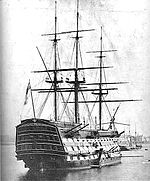Portal:Royal Navy
Selected battleThe naval Battle of Quiberon Bay took place on 20 November 1759 during the Seven Years' War in Quiberon Bay, off the coast of France near St. Nazaire. The British Admiral Sir Edward Hawke with 23 ships of the line caught up with a French fleet with 21 ships of the line under Marshal de Conflans, and after hard fighting, sank six and captured one, the rest of the fleet being forced to return to port. As a result, French naval activity was severely limited, and Britain retained naval supremacy for the remainder of the war. At the time, the battle was one of the most important and well-known British naval victories; it would remain so until the Battle of Trafalgar in 1805. Selected shipHMS Victory is a 104-gun ship of the line of the Royal Navy, built between 1759 and 1765. She was constructed at Chatham Dockyard, and was something of an unusual occurrence at the time; during the whole of the 18th century only ten first-rates were constructed. The Royal Navy preferred smaller and more manoeuvrable ships and it was unusual for more than two first-rates to be in commission simultaneously. Victory was Horatio Nelson's flagship at the Battle of Trafalgar. In 1812, her active career ended, and over the next century, she served as a depot ship and signals school before restoration work began in 1922. She opened as a museum in 1928, although conservation and restoration work is still ongoing. Currently, Victory sits in dry dock in Portsmouth as a museum ship. She is the oldest naval ship still in commission and the only remaining ship of the line except for the Regalskeppet Vasa. CategoriesSelected picture
Selected biographyAdmiral of the Fleet John Arbuthnot "Jackie" Fisher, 1st Baron Fisher of Kilverstone, GCB, OM, GCVO (25 January 1841 – 10 July 1920) was a British admiral known for his efforts at naval reform. He had a huge influence on the Royal Navy in a career spanning more than 60 years, starting in a navy of wooden sailing ships armed with muzzle-loading cannon and ending in one of battlecruisers, submarines and the first aircraft carriers. The argumentative, energetic, reform-minded Fisher is often considered the second most important figure of British naval history, after Lord Nelson. Did you know...?
Major topicsThings you can doFrom the Military history WikiProject: Requested articles Expansion needed Featured content
Associated Wikimedia
|


